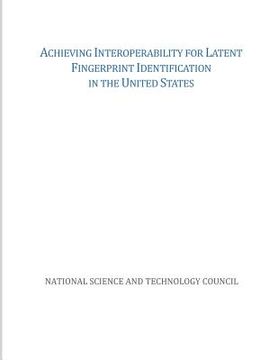Compartir
Achieving Interoperability for Latent Fingerprint Identification in the United States (en Inglés)
National Science and Technology Council
(Autor)
·
Createspace Independent Publishing Platform
· Tapa Blanda
Achieving Interoperability for Latent Fingerprint Identification in the United States (en Inglés) - National Science and Technology Council
$ 44.810
$ 56.012
Ahorras: $ 11.202
Elige la lista en la que quieres agregar tu producto o crea una nueva lista
✓ Producto agregado correctamente a la lista de deseos.
Ir a Mis Listas
Origen: Estados Unidos
(Costos de importación incluídos en el precio)
Se enviará desde nuestra bodega entre el
Lunes 05 de Agosto y el
Lunes 19 de Agosto.
Lo recibirás en cualquier lugar de Argentina entre 1 y 3 días hábiles luego del envío.
Reseña del libro "Achieving Interoperability for Latent Fingerprint Identification in the United States (en Inglés)"
Automated Fingerprint Identification System (AFIS) interoperability will support public safety throughout the United States by ensuring local law enforcement agencies are better able to coordinate their investigative fingerprinting efforts. The Federal Government has a critical role to play in implementing standards needed to achieve interoperability, developing an overarching national connectivity strategy and infrastructure, and supporting State and local agencies in building connections across jurisdictions. This report describes the current state of latent AFIS interoperability and identifies actions that can be taken by Federal agencies to support the following: Acquisition of standards-compliant systems at the Federal, State, and local-levels; Furthering connectivity efforts among law enforcement agencies; Improved governance structures to reflect the new interoperable environment; Developing mechanisms to test system performance and standards compliance; and Expanded examiner training.For over a century, fingerprints have been used among other applications to identify criminal and terrorist suspects, perform background checks, and monitor immigration status. In the context of a criminal investigation, prints found at the scene of a crime, known as latent prints, are compared with fingerprint records of known individuals who have been convicted or arrested for a crime. A "latent print" refers to any left fingerprint by an unknown source, in whole or in part, and includes those recovered from a crime scene or an item of evidence. The highly variable characteristics of latent prints complicate the identification process. When law enforcement first began using fingerprints in investigations, the comparison process was entirely manual and based on visual inspections of features found on both the latent print and the fingerprint records. AFIS systems, first introduced in the 1970s, generate a list of potential candidates that share similar fingerprint features to an encoded image of the print through the use of image recognition algorithms. The algorithms assess friction ridges and other features found on the underside of the finger and on the palm, collectively referred to as "minutiae."
- 0% (0)
- 0% (0)
- 0% (0)
- 0% (0)
- 0% (0)
Todos los libros de nuestro catálogo son Originales.
El libro está escrito en Inglés.
La encuadernación de esta edición es Tapa Blanda.
✓ Producto agregado correctamente al carro, Ir a Pagar.

